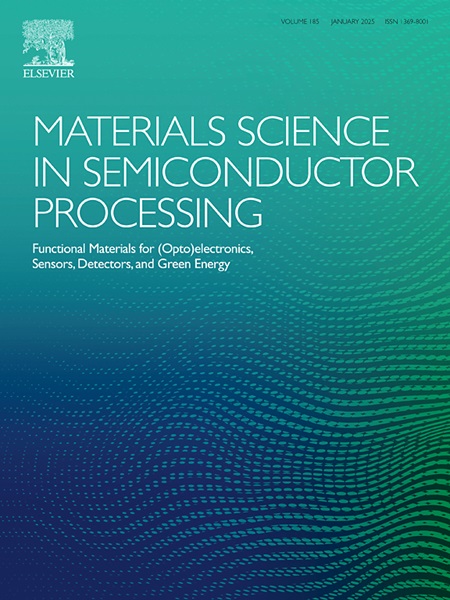具有超高载流子迁移率的新型 Janus α-Au4XY(X/Y = S、Se、Te)单层:第一原理研究
IF 4.2
3区 工程技术
Q2 ENGINEERING, ELECTRICAL & ELECTRONIC
引用次数: 0
摘要
本文从理论上提出了一系列 Janus α-Au4XY(X/Y = S、Se、Te;X≠Y)单层,并基于第一性原理计算研究了它们的结构稳定性、电子特征和输运性质。结果表明,Janus α-Au4XY 单层具有稳定的结构,可以通过实验合成。Janus α-Au4XY 单层具有较低的杨氏模量,其力学特征具有轻微的各向异性。在基态,Janus α-Au4XY 单层具有半导体特性,在导带最小值附近具有非常陡峭的带散布,这有望带来超高的电子迁移率。Janus α-Au4XY 的电子特性对双轴应变ɛxy 高度敏感,尤其是施加的压缩双轴应变。有趣的是,在ɛxy=-6% 时,α-Au4XY 的三种构型都能观察到从半导体相到金属相的转变。Janus α-Au4XY 单层表现出卓越的传输特性,电子迁移率高达 3.20×105 cm2V-1s-1(α-Au4SSe 单层)。我们的研究结果不仅探索了 Janus α-Au4XY 纳米结构出色的电子和传输特性,还表明了它们在纳米电子学和纳米机电设备中的潜在应用。本文章由计算机程序翻译,如有差异,请以英文原文为准。
Novel Janus α-Au4XY (X/Y = S, Se, Te) monolayers with ultra-high carrier mobility: A first-principles study
In this paper, we theoretically propose a series of Janus -AuXY (X/Y = S, Se, Te; X Y) monolayers and investigate their structural stability, electronic features, and transport properties based on first-principle calculations. It is indicated that Janus -AuXY monolayers have a structurally stable and can be synthesized experimentally. Janus -AuXY monolayers exhibit a low Young’s modulus and their mechanical features are slightly anisotropic. At the ground state, Janus -AuXY monolayers possess semiconducting characteristics with very steep band dispersions near the conduction band minimum, which is expected to ultra-high electron mobility. The electronic features of Janus -AuXY are highly sensitive to the biaxial strains , particularly the applied compressive biaxial strains. Interestingly, the transitions from the semiconductor to the metal phases are observed in all three configurations of -AuXY at . Janus -AuXY monolayers exhibit superior transport characteristics with the electron mobility reaching up to cmV−1s−1 (-AuSSe monolayer). Our findings not only explore the outstanding electronic and transport features of Janus -AuXY nanostructures but also indicate their potential applications in nanoelectronics and nanoelectromechanical devices.
求助全文
通过发布文献求助,成功后即可免费获取论文全文。
去求助
来源期刊

Materials Science in Semiconductor Processing
工程技术-材料科学:综合
CiteScore
8.00
自引率
4.90%
发文量
780
审稿时长
42 days
期刊介绍:
Materials Science in Semiconductor Processing provides a unique forum for the discussion of novel processing, applications and theoretical studies of functional materials and devices for (opto)electronics, sensors, detectors, biotechnology and green energy.
Each issue will aim to provide a snapshot of current insights, new achievements, breakthroughs and future trends in such diverse fields as microelectronics, energy conversion and storage, communications, biotechnology, (photo)catalysis, nano- and thin-film technology, hybrid and composite materials, chemical processing, vapor-phase deposition, device fabrication, and modelling, which are the backbone of advanced semiconductor processing and applications.
Coverage will include: advanced lithography for submicron devices; etching and related topics; ion implantation; damage evolution and related issues; plasma and thermal CVD; rapid thermal processing; advanced metallization and interconnect schemes; thin dielectric layers, oxidation; sol-gel processing; chemical bath and (electro)chemical deposition; compound semiconductor processing; new non-oxide materials and their applications; (macro)molecular and hybrid materials; molecular dynamics, ab-initio methods, Monte Carlo, etc.; new materials and processes for discrete and integrated circuits; magnetic materials and spintronics; heterostructures and quantum devices; engineering of the electrical and optical properties of semiconductors; crystal growth mechanisms; reliability, defect density, intrinsic impurities and defects.
 求助内容:
求助内容: 应助结果提醒方式:
应助结果提醒方式:


